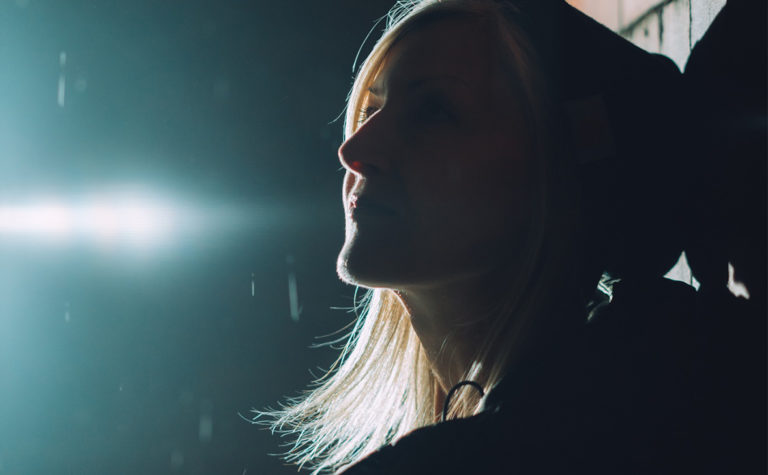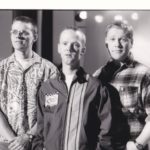One of the final acts of this year’s MIF was billed as the coming together of five of the leading female electronic music artists in the world, curated by BBC DJ Mary Anne Hobbs who also, as she’d promised, “spun a few discs”. It was “an evening of pioneering sound and breath-taking visuals” in the venerable old Ritz, probably Manchester’s longest-serving venue.
What it taught me is just how vast the range of what we lazily label ‘electronic music’ is. No two artists sounded the same or anything like it. We got everything from folk music to EDM to industrial garage, the common denominator being an electronic ‘signature.’
It was a marathon event, of five hours, and seven or more with DJ sessions at each end. One of the artists, Holly Herndon, had participated in MIF17 two years ago when she and others had performed individual sets under the (again Hobbs-curated) ‘Dark Matter’ agenda, on different nights in the sauna-like Gorilla across the road and I think it’s fair to say the majority of what was eventually close to a sell-out audience had come to see her.
First up was Sweden’s minimalistic, dark Klara Lewis, unfortunately performing in front of only a couple of hundred people. The latecomers missed what for me was the most audio-visually pleasing set of the night. If it goes to YouTube make a point of seeking it out and give yourself 45 minutes of delight. From the moment it began it was evident it would have been perfect music for the Laurie Anderson ‘To the Moon’ virtual reality experience taking place nearby. They should get together.
The best description I can come up with is a powerful choral drone. Visually it looked as if she’d flown an actual drone, or perhaps it was an aircraft taking off and ascending, over a large urban area, to the sound of the word ‘leaving’(?) repeated over and over as the choral sound rose to a crescendo. At first I thought it was Reykjavik but its size and the presence of smokestacks put that idea to bed.
As the video progresses strange things start to happen. The lights of buildings and streetlamps appear to transform into burning coals, even lava. Cumulus clouds appear, or are they birds? How can clouds ‘flap’? Then they turn into long red serpents. Later, the city turns into a Manhattan-like forest, then skyscrapers that are giant chimneys, a set of curtains and finally a futuristic space city with windows that look like faces.
I have no idea what Lewis is trying to say with this show; there’s almost certainly an environmental message in it but it made for “an immersive journey into the future”, another tag applied to this show by the MIF and got it off to a great start.
Klara Lewis – View
The next artist was the American Katie Gateley, with two separate pieces, neither of which, unfortunately, was really loud enough. When you can hear the audience more than the performance in a show like this something is wrong and as a result she couldn’t hold its attention sufficiently.
She had no supporting visual other than some subtle spots but added to her performance with live vocals and seemed actually to be playing an instrument at times. The first piece was in the manner of an electronic lullaby and the second one more powerful, with the sound of war drums building into a persistent drone and ultimately a gigantic buzz saw. She’s billed as ‘unpredictable’ and this set certainly was.
Katie Gateley – Color
As indeed was the following one, by ‘the alchemist’ Aïsha Devi. The radical Berlin-based artist has a particular interest in club music and it shows. She worked with a visual artist, MFO (Marcel Weber) on a special collaborative piece for this performance, which was the original reason Mary Anne Hobbs and MFI put a large screen into the venue. Weber has an impressive CV that embraces work with the Barbican, Centre Pompidou and Opera National de Paris.
What we got on the night, apart from the stage being covered in silver foil, was a high class light show as Devi opened her hour long act with a red light, smoke filled interpretation of Dante’s Inferno, or so it seemed. Thereafter she moved through a set where much of the music approximated to EDM, punctuated by indefinable sounds (one was like a theremin and evoked bad 1950’s sci-fi movies) and occasionally played at a speed that only Roadrunner could dance to.
And she can sing, too, in a soprano voice that falls between operatic and metal.
The total experience was exhilarating if occasionally disorganised while the light show, with a perfect balance between many flashing spots and strobes and a beautiful ultra violet display reflecting off the silver foil, accompanied her music seamlessly.
The performance ended with what sounded like multiple AK47 fire and by now we were in need of something a little more sedate.
Aïsha Devi – Mazdâ
That came in the shape of Holly Herndon, whose show was quite different to the solo one she put on two years ago as she became a master of ceremonies and occasional singer this time out, overseeing a five-strong choir and a deck man to perform most recent album ‘Proto’. It was completely different again to what had gone before tonight, and for someone who dabbles extensively in artificial intelligence as she did on Proto’ (including one track where a computer was given free rein to write it) in addition to two preceding albums built out of computers, technology and surveillance, it was very ‘human’ in nature in the flesh.
Indeed at one time the stage took on the appearance of a gospel choir with excellent harmonies singing electronic anthems.
Meanwhile, ticking over slowly in the background if you could take your eyes off the motley crew that made up the choir, was one of the more intriguing visual presentations of the night, which varied between her wired up face in ‘Eternal’ (below) from ‘Proto’ to scenes which were something akin to an amalgam of Bowman’s trip down TMA-1 at the end of ‘2001 – A Space Odyssey’ and Jodie Foster’s walk down the beach to meet her late father/alien imposter at the end of ‘Contact’ and in the most vivid colours I can recall on such a video.
Holly Herndon – Eternal
There is something disquieting but sensual and peaceful about her music. I was hoping she would perform ‘Lonely at the Top’, from ‘Platform’, a softly spoken piece that convinces you, the listener, that you are the daddy, because it’s like nothing you’ve heard before and would be a huge challenge ‘live’. It is intended to trigger Autonomous Sensory Meridian Response, the tingle you get from the base of your skull down your back while listening to a great piece of music for example. ‘Head orgasm’ as she’s called it.
When Jlin took to the stage I needed a head orgasm myself. Jlin, who has recorded with Holly Herndon, though I don’t see what they’ve got in common, was chalk and cheese not only to Herndon but the all the other preceding artists.
She’s very much flavour of the month with the heavyweight music press owing to being recognised as one of the most original voices in electronic music, having “transcended” the boundaries of the Chicago footwork (music/dance) movement where she began, for having composed the score to ‘AutoBIOgraphy’ for choreographer Wayne McGregor, and she is credited with summoning up the most innovative beats and rhythm patterns in any genre.
The work she played tonight was another World Premiere, created for ‘Songs of the Lost’, a game designed by Paloma Dawkins and collaborators. It was promoted as “a psychedelic audiovisual experience, with a pulsing, shape-shifting soundtrack for a magic-realist game odyssey through a surreal and absurd digital landscape. You’ll cross boundaries and traverse borders, roam hidden highways and meet enigmatic strangers, explore secret forests and enter the void on your journey to Apocabliss, the last safe haven…”
It seems Jlin worked in an Indiana steel mill to support herself through her early career and ‘Songs of the Lost’ is most distinctly industrial. It might have been the lateness of the hour but those innovative beats sounded like someone had programmed a drum machine at Warp Factor 10 and the first ten minutes might have been the soundtrack to World War 3. What finished me off though was the unrelenting mob attack by strobe light. In between the flashes I could see the audience below me trying to dance to something with a ‘beat’ you couldn’t set a time signature to because artificial intelligence hasn’t discovered one yet. I was yearning for the graceful serenity of Klara Lewis and it was time to go.
Jlin – Black Origami
One thing I did take away with me was the fascination of how some exponents of this genre are still using decks with masses of wiring like spaghetti that’s run amok, which they wrestle with, while in other cases its clean cut and sanitised as they peer occasionally at a pristine new Apple laptop and even less frequently actually tap it. The earlier two artists were the ‘wiring’ people and I do prefer that, it seems so much more appropriate to the sounds they are producing.
So some great performances in this, one of the penultimate shows of MIF19, while one of them failed to hit the mark with me, even while I appreciate the skill which goes into the production.
As with all the MIF productions that I saw the organisers should be congratulated for the insight and vision which served up something truly different and special. While I have doubted it in the past, on this occasion I can acknowledge the claim that MIF has become a genuine World Class event.




